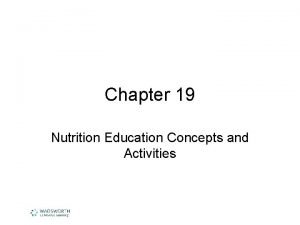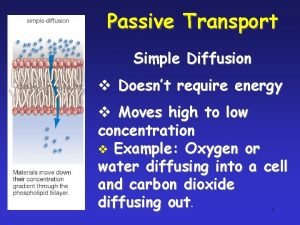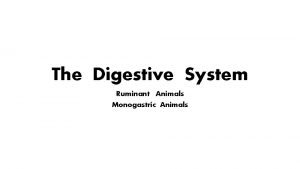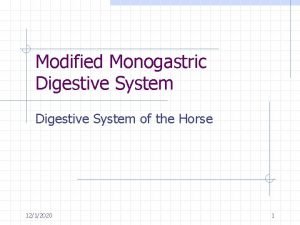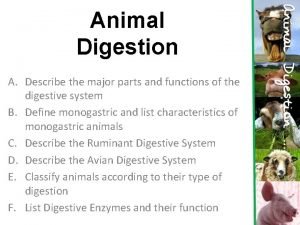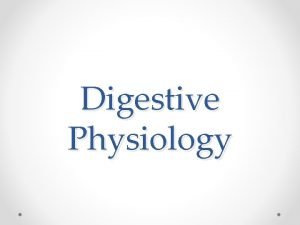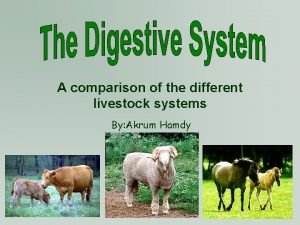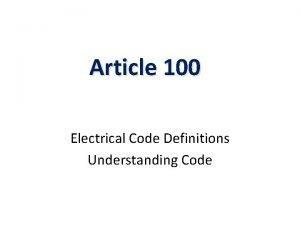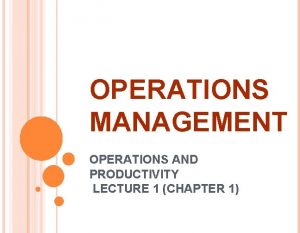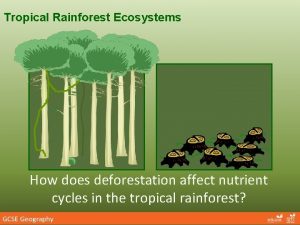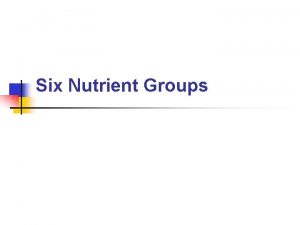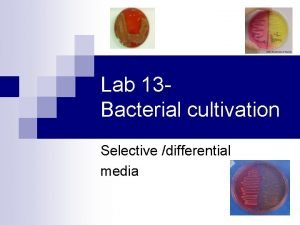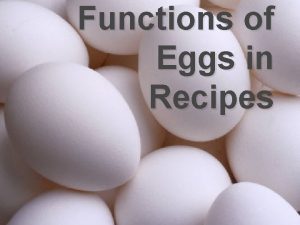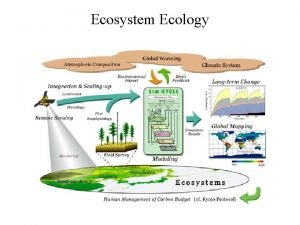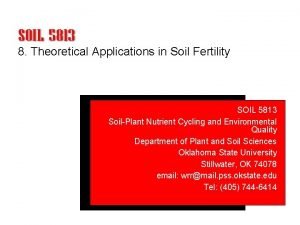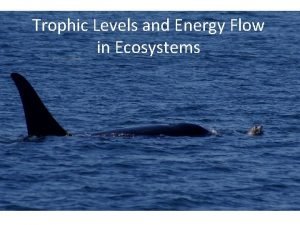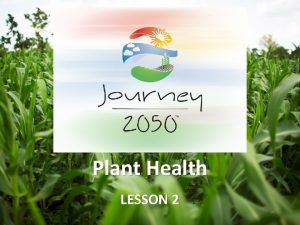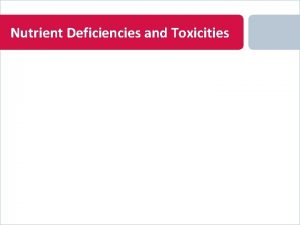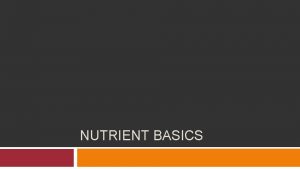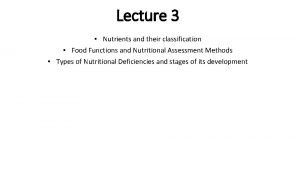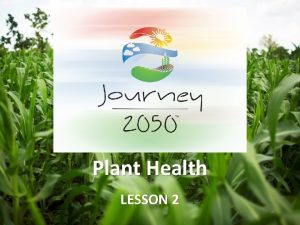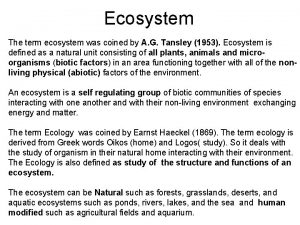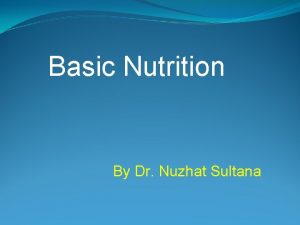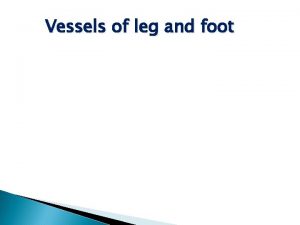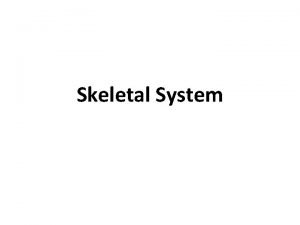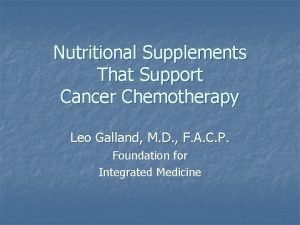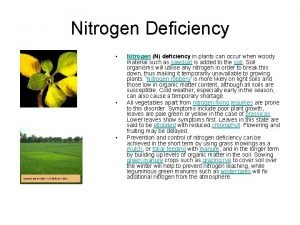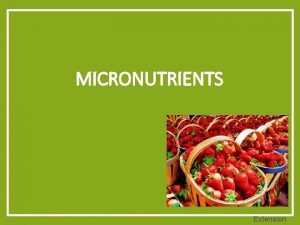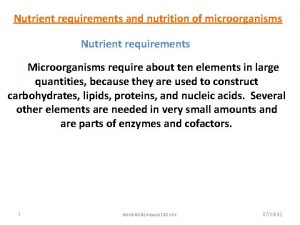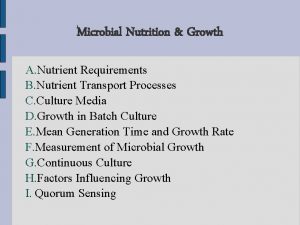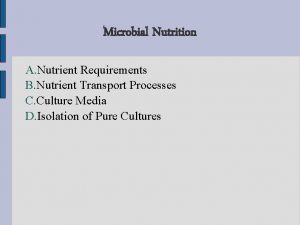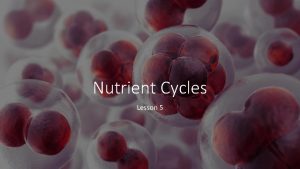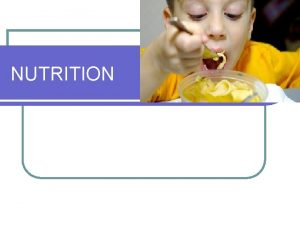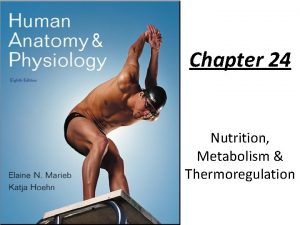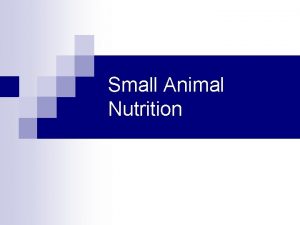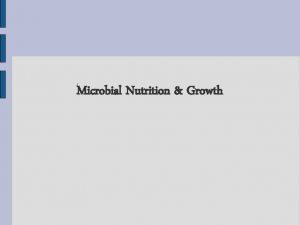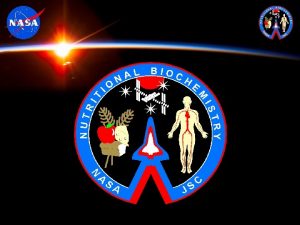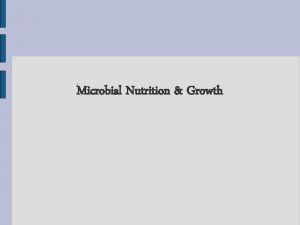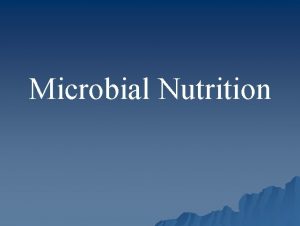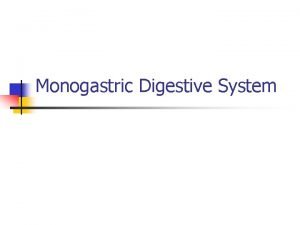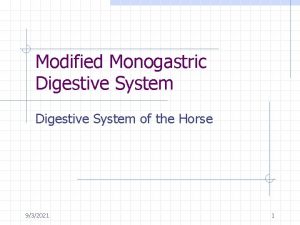Monogastric Nutrition Nutrient Requirements Simple Stomached Require readily





































- Slides: 37



Monogastric Nutrition

Nutrient Requirements • Simple Stomached – Require readily digestible feed – Cannot use complex carbohydrates • Cellulose, hemicellulose, etc. – Require essential amino acids – Cannot synthesize amino acids • Poor quality protein, NPN • Water

Water • Important nutrient • 55 -80% of animal is water – Depends on age • Uses – Hydration, medium for moving wastes into and out of body – Component of milk, lubricates joints, cushions nerves, disperses heat, protects developing fetuses

Water • Free access to water – Cool, Clean, Abundant – Pigs will consume 1 -1. 5 quarts / pound of feed – Limiting water intake results in poor production • Decreased intake • Poor feed efficiency • Reduced milk production

Energy • Required for basic processes – Acquired from carbohydrate, fat, protein metabolism • Obtained from Corn, Soybean meal, fat – Some cases, energy may be limiting factor for growth

Energy • Energy requirements – Influenced by: • Weight (Direct influence on maintenance) • Genetic ability to produce lean tissue • Environmental temperature – Most often expressed as • Digestible Energy (DE) • Metabolizable Energy (ME) • For all weight classes, ME requirement is approx. 96% of the DE requirement

Energy Table 23 -1

Energy Table 23 -3

Energy Table 23 -4

Energy Table 23 -6

Protein & Amino Acids • Protein makes up portions of muscle, blood, enzymes, hair, etc. • 7 -9% of the pig’s body is edible protein • Protein consists of 22 different amino acids • For growth to occur at a rapid rate, the ration must supply 10 of the 22 amino acids

Protein & Amino Acids • Essential amino acids: One in which the body cannot manufacture in sufficient quantity to permit maximum growth and performance • Non-Essential amino acids: Amino acids which can be synthesized in large enough amounts to permit maximum growth as long as sufficient Nitrogen is present.

Protein & Amino Acids

Protein & Amino Acids • Lysine is the #1 essential or limiting amino acid in swine diets – Lysine concentration is high in muscle – Lysine content of most feedstuffs is low • Feeding high quality proteins is essential – Contains all essential amino acids in the correct proportions and amounts – Possible to perform better on a 12% CP vs. 16% CP

Protein & Amino Acids • Soybean meal – Used as the primary protein source in swine diets • 85% of lysine digested & absorbed by pig • Versus 65% of lysine in meat & bone meal – Complements corn well in the diet • Swine diets formulated approximately 79% corn to 20% soybean meal. (+/- 1 -2 %) • Trying to correct the deficiencies in the cereal grain

Vitamins & Minerals • Pigs are most likely to suffer from vitamin & mineral deficiencies 1. Primarily fed cereal grains low in minerals, particularly calcium 2. Skeleton supports greater weight in proportion to its size than other farm animals 3. Fed to grow at a maximum rate and are marketed before they mature 4. Reproduce at a younger age 5. Raised in a confinement setting.

Vitamins & Minerals • Minerals – Very important functions – Required only in very small amounts – Pigs require 13 different minerals in the diet – Minerals deficient in corn & soybean meal diets • Calcium (Ca), Phosphorus (P), Sodium (Na), Chlorine (Cl), • Trace minerals: Iron (Fe), Zinc (Zn), Iodine (I), Selenium (Se)

Vitamins & Minerals • Minerals – Calcium & Phosphorus are the most critical and are required in the greatest amounts • Adequate levels will provide a strong skeletal structure • Deficiencies will lead to poor bone mineralization – Important when raised in confinement on concrete floors • Ideal ratios of Ca: P should lie between 1: 1 and 1. 25: 1

Vitamins & Minerals • Vitamins – Complex organic compounds needed in minute amounts, which are essential for health and normal body functions – Pigs require 15 vitamins in very small amounts – Many of these are likely to be deficient in corn & soybean meal diets

Vitamins & Minerals Table 19 -6, R. O. Kellems and D. C. Church

Additives • Substances added to swine rations to enhance performance – Feed-grade fat • • Can be added at 5% of the total ration Added as an energy source Reduces dustiness of feed and increases palatability To be economical, cost must be no more than 2. 5 to 3. 0 times the cost of corn

Additives Table 19 -10, R. O. Kellems and D. C. Church

Additives • Antimicrobial agents, anthelmintics • Antimicrobials – Added to stimulate growth and feed efficiency, and to reduce mortality • Low levels (Subtherapeutic) – Promote growth • Moderate-to-high levels (Prophylaxis) – Prevention of disease in exposed animals • High levels (Therapeutic) – Treatment of disease

Additives • Anthelmintics – Used to prevent or remove internal parasites • Roundworms & Lungworms • Some will control external parasites – Lice, Mange – Ivermectin • Considered drugs and are regulated by the FDA – Only certain types, levels, and combinations are approved for use in swine diets

Additives Table 19 -15, R. O. Kellems and D. C. Church

Additives Table 19 -16, R. O. Kellems and D. C. Church

Management • 75 -80% of the total cost associated with swine production are feed costs • Intense management is required • Feed manufacturers and producers must evaluate the cost effectiveness and feed value in order to formulate cost effective and nutritionally adequate swine diets • Generic diet formulation may be a problem in formulating cost effective gains

Management • Phase Feeding – Adjusting the ration according to the individual pig’s nutrient needs as it grows – Depending on the intensity of the management system, rations can also be adjusted based on sex of the pig

Management

Management • The end goal of the feed manufacturer and producer is to cost effectively produce pigs which will reach market weight (250 -280 lbs) in the shortest amount of time with a minimum amount of fat and maximum amount of lean tissue your genetics will allow.





 Salmonella transport media
Salmonella transport media Foods used in nutrition activities should be nutrient-dense
Foods used in nutrition activities should be nutrient-dense Does simple diffusion require energy
Does simple diffusion require energy What is this
What is this Monogastric animal
Monogastric animal Modified monogastric examples
Modified monogastric examples Monogastric animals
Monogastric animals Diagram of pig digestive system
Diagram of pig digestive system Modified monogastric
Modified monogastric A multiwire circuit must consist of conductors connected to
A multiwire circuit must consist of conductors connected to Operations and productivity
Operations and productivity Readily achievable barrier removal
Readily achievable barrier removal Ridge characteristics definition
Ridge characteristics definition Sulfur readily forms the following monatomic ion:
Sulfur readily forms the following monatomic ion: What does readily forgive others mean
What does readily forgive others mean At stp which gas will diffuse more readily than ne
At stp which gas will diffuse more readily than ne Termination of brachial artery
Termination of brachial artery How does deforestation affect the nutrient cycle
How does deforestation affect the nutrient cycle Nnn plant protein
Nnn plant protein Nutrient agar with tellurite is selective/differential for
Nutrient agar with tellurite is selective/differential for Eggs as emulsifier
Eggs as emulsifier Nutrient cycle in the serengeti
Nutrient cycle in the serengeti Gersmehl model deciduous woodland
Gersmehl model deciduous woodland Brays nutrient mobility concept
Brays nutrient mobility concept Nutrient chain foldable
Nutrient chain foldable Journey 2050 student handout 2 word search
Journey 2050 student handout 2 word search Nutrient deficiency
Nutrient deficiency Nutrient basics
Nutrient basics Classification of nutrients
Classification of nutrients Journey 2050 student handout 3 crossword puzzle
Journey 2050 student handout 3 crossword puzzle The term ecosystem was proposed by *
The term ecosystem was proposed by * Nutrition defination
Nutrition defination Apes cycles
Apes cycles Foot artery
Foot artery Skeletal system
Skeletal system Tamoxifen nutrient depletion
Tamoxifen nutrient depletion Nutrient deficiency in tomatoes
Nutrient deficiency in tomatoes Nutrient interactions
Nutrient interactions

